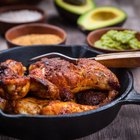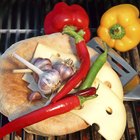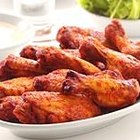VeryUlissa/iStock/GettyImages
You can only fit so many hamburgers on a grill at one time, which often means some guests at a cookout either eat before everyone else, or eat cold burgers. Everyone can eat a hot burger at the same time if you cook the burgers ahead of time, and keep them hot until time to eat. If you cook the burgers all the way through and place them in a warmer, the burgers end up dry and flavorless. The best option is to develop a crust on the outsides, leaving the undercooked center to finish cooking through in the warmer.
Preheat one side of the grill to high or medium-high. With a gas grill, this simply means igniting the burner on only one side of the grill. If you have a charcoal grill, stack the charcoal in a pyramid on one side of the grill, and when the coals turn gray with ash, spread them only across half the grill. The hot side is used for direct cooking, while the cool side receives just enough heat to keep the burgers hot.
Place the burgers on the hot side of the grill. Grill the hamburgers for about 2 to 3 minutes, until the bottom side develops a brown crust. Flip the burgers over and cook for another 2 to 3 minutes to develop a crust on the other side, or until the internal temperature rises to 140 degrees Fahrenheit. Insert a meat thermometer in the thickest part of each burger to register the temperature. Burger thickness varies, so a thermometer is necessary to determine how well done each burger is cooked.
Transfer the burgers from the hot side of the grill to a metal or aluminum baking pan set on the cool side of the grill. Cover the pan to keep the heat contained around the burgers. Disposable aluminum baking pans with lids work particularly well, or you can cover a metal baking pan with aluminum foil. Leave the burgers in the pan until ready to serve, allowing the temperature to rise to a minimum of 160 F, the safe internal temperature for ground meat.
Cook the remaining burgers in batches on the hot side of the grill. Transfer them to the baking pan on the cool side to finish cooking. As you get down to the last few batches, cook them to a hotter temperature on the grill because they will have less time in the baking pan for the temperatures to rise. If you plan to eat as soon as the last batch of burgers is done, cook the last batch until the internal temperature reaches 160 F.
Check the internal temperature of each burger just before serving at the cook-out. If some of the burgers haven't reached 160 F, place them on the hot side of the grill for another few minutes, or as long as needed to raise the temperature to 160 F. If all the burgers have reached 160 F, but you won't be serving them right away, cover the pan and keep them at a minimum temperature of 140 F until serving time. The burgers must cook to 160 F to kill all bacteria, but they only need to be 140 F at serving time to keep them out of the danger zone for bacterial growth.
Related Articles
Cooking Hamburgers for a Large Group
How to Keep Waffles Hot at a Brunch
How to Hold Hamburgers in a Steam Tray
Can You Cook Chicken Wings the Day ...

How to Cook a Frozen Pizza on the ...

How to Cook the Perfect Burger Indoors ...

How to Make Sure Your Hamburger Is ...

How to Reuse Cedar Cooking Planks

How to Fry Taquitos Without Them ...

The Best Ways to Cook Hot Chicken Wings ...
How to Cook Multiple Hot Dogs

How Many Calories in KFC Hot Wings?

How to Cook Venison Steaks With Onions

How to Keep Hamburgers From Puffing Up ...
How to Keep Biscuits Warm in a Chafing ...

How to Grill a Pizza on an Open Fire

The Difference Between Grilling & Oven ...

How to Cook Filet Mignon Medallions on ...

Grilling Instructions for Rib-Eye Steak

How to Make Easy Baked Spicy Chicken ...
References
Tips
- If you are serving a very large cookout, use two smaller pans instead of one large pan so you can better monitor which burgers have been in the pans for the longest amount of time.
Writer Bio
A former cake decorator and competitive horticulturist, Amelia Allonsy is most at home in the kitchen or with her hands in the dirt. She received her Bachelor's degree from West Virginia University. Her work has been published in the San Francisco Chronicle and on other websites.